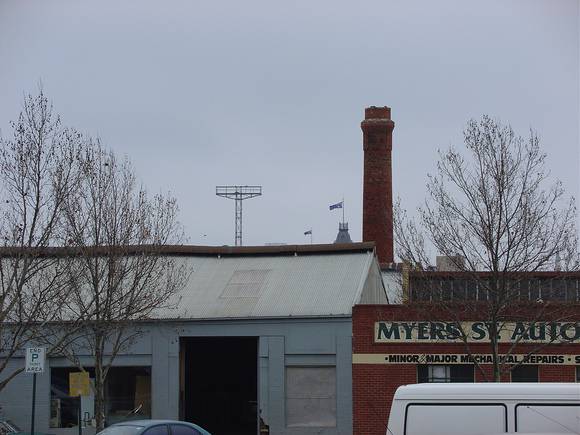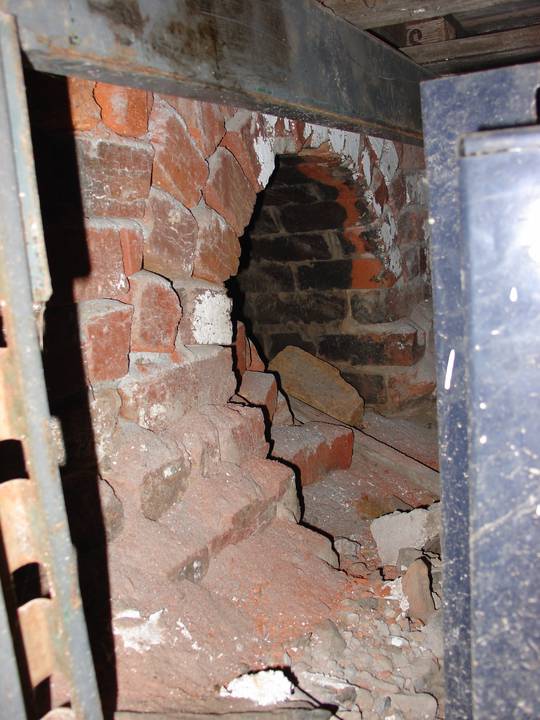| Back to search results » | Back to search page » |
|
Chimney, Sandhurst Rolling Stock Works (former)
Location25 Myers Street, BENDIGO VIC 3550 - Property No 173829 LevelIncluded in Heritage Overlay |
|
Statement of Significance
Historical research and inspection of the property at 25 Myers Street
shows that substantial structures survive in relation to the Sandhurst
Rolling Stock works, and that these date to around 1890 although
altered in the early 20th century. The significant components of the site can be summarised as follows:
Feature Date (s) Significance Management
Chimney c1886, altered c1900? Primary - reflects major visible
feature associated with Sandhurst Rolling Stock Co Works. Should be
retained and conserved West wall c1886 or earlier, minor changes in 1920s-30s Primary -
oldest surviving fabric relating to Sandhurst Rolling Stock Co Works.
Should be retained and conserved Roof structure & remains of timber wall frames Possibly 1890s,
reclad in 1940s, Contributory - may be of late date, but provides main
context for other features and retains industrial character of the
site. Could be altered or replaced, but new structure to remain within
current building envelope and respect original finishes, forms and designs. Facade 1960s No significance apart for providing structural integrity
to rest of building New development should ensure facade design to
historic character. Archaeological remains 1876 on Primary - relates to origin of the
works on this site, and potential structural remains of former
buildings and structures. Protection under heritage inventory listing
with appropriate conditions for monitoring/excavation in any future
planning approvals The present building at 25 Myers Street appears to be an amalgam of
several periods. The main structure is of early 20th century date
(1920s-40s, but incorporates earlier elements such as the west wall
with its arched openings, and the push pole structure along the east
wall. This is probably of late nineteenth century date and may be the
external wall of the former adjoining structure originally on the
petrol station site. An 1886 painted birds-eye-view (Meadows 1886)
shows a long, two storey, gable roofed building running along the
north side of Williamson Street frontage to the corner of Myers
Street. This building also appears in a photo in the Bendigo Library
and Museum Victoria collections, (probably from around 1890), which
also shows "STEAM CARRIAGE WORKS" painted on the roof. It is
likely that the dividing wall between this and the structure to the
north east was brick, at least for the ground floor. Some hand made
bricks in this wall may also relate to an even earlier structure. The
existing low pitched gable roofs are similar in form to those shown in
the c1890 photograph. The asbestos cement is of c1940s date, probably
involving the recladding of an earlier corrugated iron roof. Other single storey buildings further west along Williamson Street,
include signage on the parapet identifying the carriage works
showrooms. It is unclear if these survive, although the extant
buildings at 61-65 Williamson Street are of a suitable age for such an
association. A chimney is shown (in about the location of the existing chimney) in
the 1886 painting and the c1890 Bendigo Library / Museum of Victoria
photograph. However, this appears to be of a slightly different form
to the existing chimney and somewhat taller. It is possible that this
taller chimney was subsequently reduced in height and remodelled.
Another shorter chimney is located to the north at the rear of 61-65
Williamson Street. The Bendigo Water Board Sewerage connection plan for 1924 shows a
boiler located at the rear of 25 Myers Street, oriented across the
block near the eastern boundary. This would conform to a location
immediately south-west of the present chimney. The chimney is therefore most likely of late nineteenth century date
(c1886) but having been altered in the early twentieth century but no
later than 1940. There is therefore a period of at least a decade of
association between the operation of Sandhurst Rolling Stock Works
operation and the construction of the chimney and substantial parts of
the present building. The main elements of the building and chimney would accord with a
date of c1886 or possibly c1900 (when the rate books show a
substantial increase in value from an average NAV of £10 to £45).
However, several elements are clearly later, such as the 1940s roofing
and 1960s facade. There is almost certainly archaeological evidence association with
the former boilers and engine foundations to the south and/or west of
the chimney. Other sub-floor evidence across the site may also
survive, particularly on to the north of the block where leveling the
natural slope has probably resulted in former floor levels and the
waste products of manufacture) being buried (the original factory
floor was probably packed earth). Listing of the whole site on the
Heritage Inventory would therefore be appropriate. Significance Historically the site of Pickles Carriage Works and the Sandhurst
Rolling Stock Works, is significant as a major part of Bendigo's
manufacturing industry which grew in response to the needs and revenue
generation of the gold rush period, and went on to establish Bendigo
as a major regional industrial city. The site represents the once prolific, but now almost obliterated
industrial character of the areas south and east of the commercial
centre of Bendigo. From an historical viewpoint the chimney is also
highly significant as an example of the contribution of this local
industry to the development of Bendigo and perhaps the State. The surviving elements of the site are associated with one of the few
private railway locomotive or rolling stock manufacturers in Victoria
(in comparison with Wright and Edwards and P Bevan in Melbourne and
Phoenix Foundry in Ballarat). It is the only surviving evidence
relating to a private rolling stock works in Victoria, which was one
of largest individual employers in Bendigo in the late nineteenth
century with up to 300 employed in 1891 (McKay 1868) and was described
as "the largest carriage factory on the Australian
continent" in 1890 (Bendigo Advertiser 2.1.1890). The works was
responsible for significant number of rail carriages including
passenger carriages, brake vans, open wagons, explosives wagons, horse
boxes, guard vans, goods vans, providing an important part of the
Victorian railways rolling stock at a time when Bendigo was the second
most important terminus on the railway system. The brick chimney is a rare surviving factory chimney,
architecturally notable for is specialized construction using shaped
(tapered and curved bricks) and the simple decorated cap employing
stringcourse and vertical ribs. As such it reflects a time when tall
smoking factory chimneys dotted the skyline of Bendigo as symbols of
prosperity and growth. It is a notable landmark in the commercial
centre of Bendigo providing a visual reference to the former
manufacturing district. Only a handful of brick chimneys survive in Bendigo, other examples
being found at the Webb flour Mill, Bendigo Gas Works, North Deborah
Mine, T & S Scott's steam powered roller mill of 1887 and the
School of Mines, although none of these were related to manufacturing
in the sense of the Rolling Stock Works. A search of comparable brick
factory chimneys (including mines) reveals about 40 relatively intact
chimneys and perhaps 100 remains of fallen or demolished chimneys
throughout Victoria. Of these fewer than 20 are comparable either in
function or form. The gable roofed building is of interest in that it reflects the
later evolution of the site, while retaining the industrial character.
The bricked up archways demonstrate the former connections between
this and other buildings associated with the works, and hint at the
much greater former extent of the factory.
Group
Transport - Rail
Category
Other - Transport - Rail









